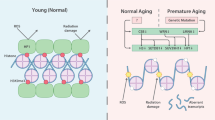Overview
DNA damage can lead not only to mutations and chromosome abnormalities, but also to epigenetic effects on gene expression. It is therefore very important to consider the possible effects of oxidative damage to DNA on epigenetic controls. In somatic cells of higher organisms there are two heritable systems which exist side by side (Holliday, 1990). Classical genetics is concerned with the inheritance of differences in DNA sequences. These differences are transmitted through mitosis and meiosis and can only be reversed or changed by rare mutations. Epigenetics is the study of the changes in gene activity during development. The epigenetic basis for gene expression can be stably inherited through mitosis, since specialised differentiated cells which divide maintain their phenotype. However, there can also be instability, since stem line cells can divide both to form cells which will later differentiate, and also cells which retain their stem cell function. Whereas classical genetic inheritance is concerned with individual cell lineages, epigenetic changes during development commonly occur in groups of cells sometimes called “polyclones” (Crick and Lawrence, 1975). Such changes may be strongly influenced by external effectors (morphogens, hormones, growth factors, or other diffusible agents), whereas the genetic information embodied in DNA sequences is not changed by external influences. Epigenetic changes are commonly reversed in each generation, for example, the inactive X chromosome in female mammals is reactivated before the gametes are produced. The process of genomic imprinting depends on the addition of information to DNA which is different in male and female gametes. Imprinting can also be regarded as an epigenetic mechanism, which can be reversed in each generation.
Access this chapter
Tax calculation will be finalised at checkout
Purchases are for personal use only
Preview
Unable to display preview. Download preview PDF.
Similar content being viewed by others
References
Achten, S., Behn-Krappa, A., Ricker, M., Sprengel, J., Hölker, I., Schmitz, B., Tesch, H., Diehl, V. and Doerfler, W. (1991) Patterns of DNA methylation in selected human genes in different Hodgkin’s lymphoma and leukemia cell lines and in normal human lymphocytes. Cancer Res. 51: 3702–3709.
Antequera, F., Boyes, J. and Bird, A. (1990) High levels of de novo methylation and altered chromatin structure of CpG islands in cell lines. Cell 62: 503–514.
Behn-Krappa, A., Hölker, I., Sandaradusa de Silva, U. and Doerfler, W. (1991) Patterns of DNA methylation are indistinguishable in different individuals over a wide range of human DNA sequences. Genomics 11: 1–7.
Brown, S. and Rastan, S. (1988) Age-related reactivation of an X linked gene close to the inactivation centre in the mouse. Genet. Res. 52: 151–154.
Cooney, C.A. (1993) Are somatic cells inherently deficient in methylation metabolism? A proposed mechanism for DNA methylation loss, senescence and aging. Growth, Development and Aging 57: 261–272.
Crick, F.H.C. and Lawrence, P.A. (1975) Compartments and polyclones in insect development. Science 189: 340–347.
Cutler, R.G. (1982) The dysdifferentiation hypothesis of mammalian aging and longevity. In: E. Giacobini, F. Filogamo, G. Giacobini and V.A. Vernadakis (eds): The Aging Brain: Cellular and Molecular Mechanisms of Aging in the Nervous System, Raven, New York, pp 1–19.
Holliday, R. (1979) A new theory of carcinogenesis. Br. J. Cancer 40: 513–322.
Holliday, R. (1987) The inheritance of epigenetic defects. Science 238: 163–170.
Holliday, R. (1989) X chromosome reactivation and ageing. Nature 337: 311.
Holliday, R. (1990) Paradoxes between genetics and development. J. Cell Science 97: 395–398.
Holliday, R. (1995) Understanding Ageing. Cambridge University Press.
Holliday, R. and Ho, T. (1991) Gene silencing in mammalian cells by uptake of 5-methyl deoxycytidine 5’ triphosphate. Somat. Cell Mol. Genetic. 17: 537–542.
Jost, J.P. and Saluz, H.P. (1993) DNA Methylation: Molecular Biology and Biological Significance, Birkhäuser, Basel.
Kastan, M.B., Gowans, B.J. and Lieberman, M.W. (1982) Methylation of deoxycytidine incorporated by excision repair synthesis of DNA. Cell 30: 509–516.
Kochanek, S., Toth, M., Dehmel, A., Renz, D. and Doerfler, W. (1990) Inter-individual concordance of methylation profiles in human genes for tumor necrosis factors a and R. Proc. Natl. Acad. Sci. USA 87: 8830–8834.
Kochanek, S., Radbruch, A., Tesch, H., Renz, D. and Doerfler, W. (1991) DNA methylation profiles in human genes for tumor necrosis factors a and 13 in the subpopulations of leukocytes and in leukaemia, Proc. Natl. Acad. Sci. USA 88: 5759–5763.
Lieberman, M.W., Beach, L.R. and Palmiter, R.D. (1983) Ultraviolet radiation-induced metallothionein-I gene activation is associated with extensive DNA demethylation. Cell 35: 207–214.
Lindop, P.J. and Rotblat, J. (1961) Shortening of life and causes of death in mice exposed to single whole-body dose of radiation. Nature 189: 645–648.
Migeon, B.R., Axelman, J. and Beggs, A.H. (1988) Effect of ageing on reactivation of the human X-linked HPRT locus. Nature 335: 93–96.
Neary, G.J. (1960) Ageing and radiation. Nature 187: 10–18.
Nyce, J. (1991) Gene silencing in mammalian cells by direct incorporation of electroporated 5-methyl-2’deoxycytidine 5’-triphosphate. Somat. Cell Mol. Genet. 17: 543–550
Wareham, K.A., Lyon, M.F., Glenister, P.H. and Williams, E.D. (1987) Age-related reactivation of an X-linked gene. Nature 327: 725–727.
Weitzman, S.A., Turk, P.W., Milkowski, D.H. and Kozlowski, K. (1994) Free radical adducts induce alterations in DNA cytosine methylation. Proc. Natl. Acad. Sci. USA 91: 1261–1264.
Wilson, V.L. and Jones, P.A. (1983) DNA methylation decreases in ageing but not in immortal cells. Science 220: 1055–1057.
Wilson, V.L., Smith, R.A., Ma, S. and Cutler, R.G. (1987) Genomic 5-methyl deoxycytidine decreases with age. J. Biol. Chem. 262: 9948–9951.
Author information
Authors and Affiliations
Editor information
Editors and Affiliations
Rights and permissions
Copyright information
© 1995 Birkhäuser Verlag Basel/Switzerland
About this paper
Cite this paper
Holliday, R. (1995). DNA damage and epigenetic mechanisms of aging. In: Cutler, R.G., Packer, L., Bertram, J., Mori, A. (eds) Oxidative Stress and Aging. Molecular and Cell Biology Updates. Birkhäuser Basel. https://doi.org/10.1007/978-3-0348-7337-6_8
Download citation
DOI: https://doi.org/10.1007/978-3-0348-7337-6_8
Publisher Name: Birkhäuser Basel
Print ISBN: 978-3-0348-7339-0
Online ISBN: 978-3-0348-7337-6
eBook Packages: Springer Book Archive




